Communication and Mass media Lesson 7 1

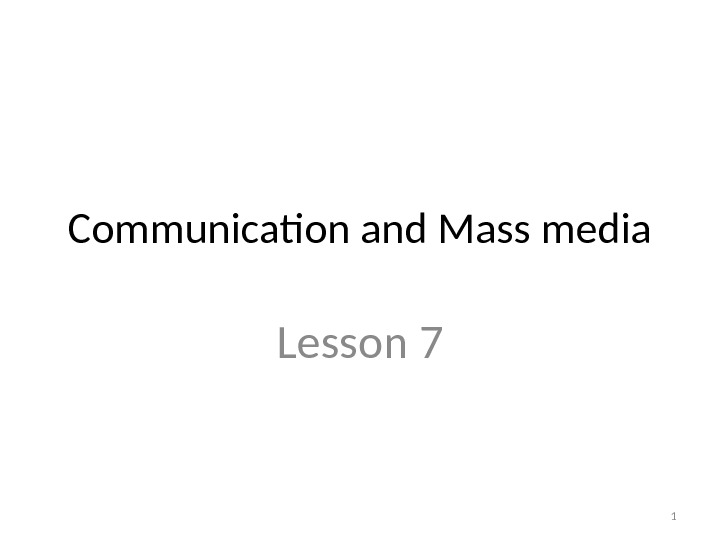

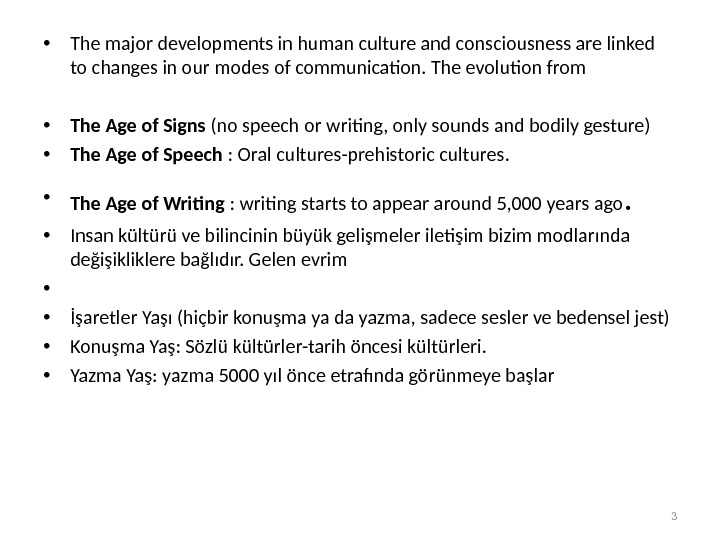

















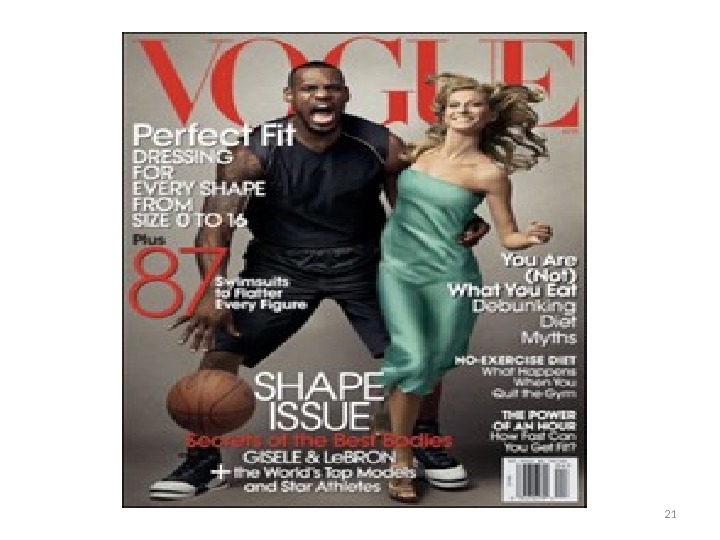



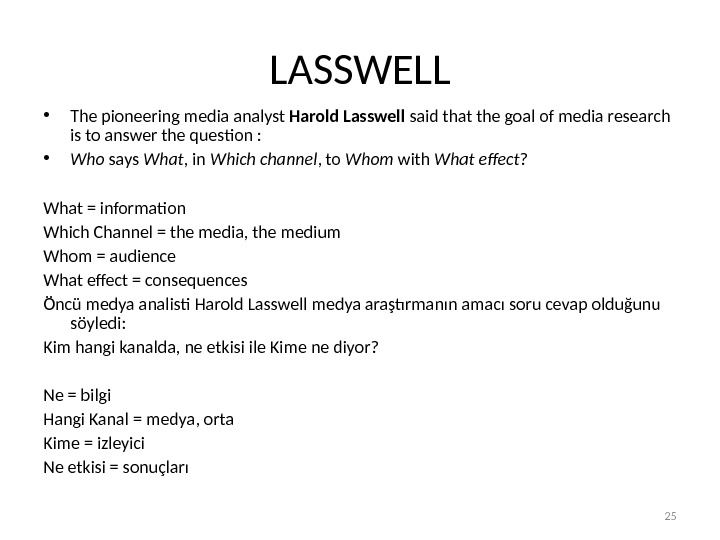


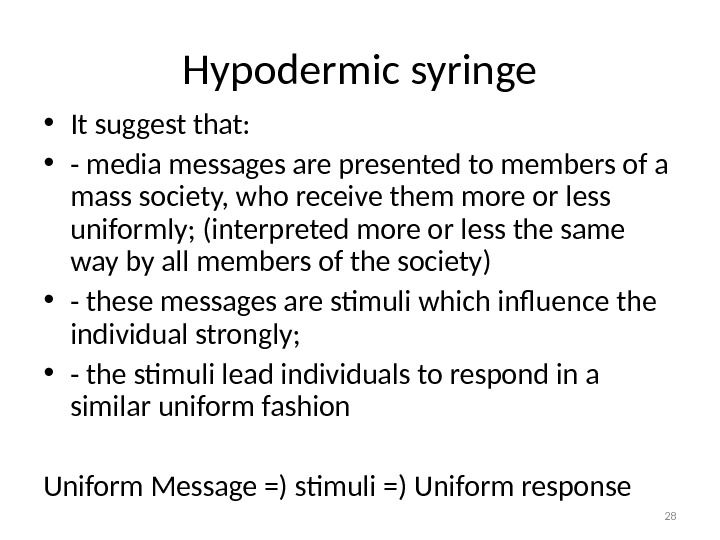







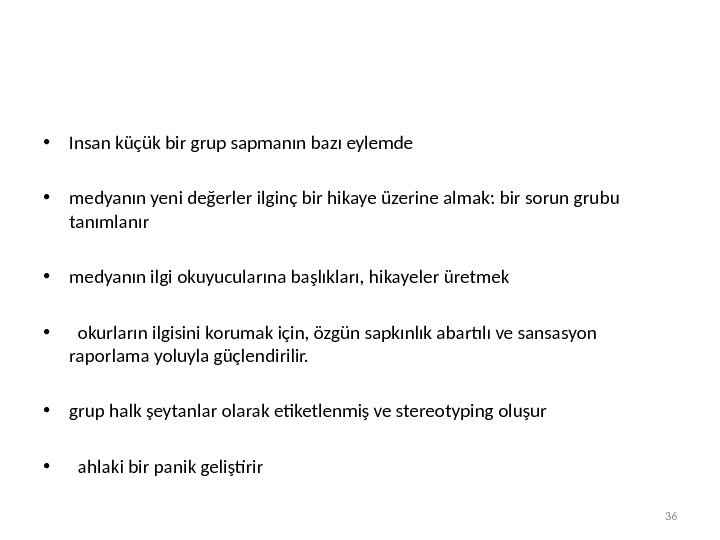

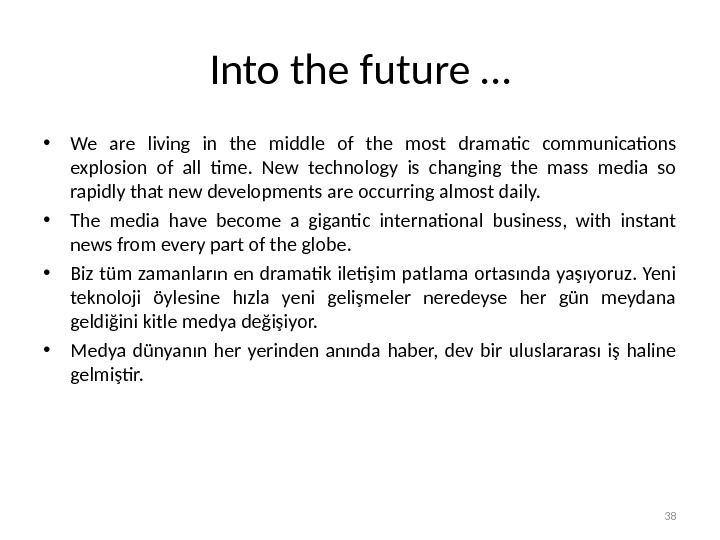


- Размер: 1.2 Mегабайта
- Количество слайдов: 40
Описание презентации Communication and Mass media Lesson 7 1 по слайдам
 Communication and Mass media Lesson
Communication and Mass media Lesson
 • The history of societies can partially be written as the history of media communication. • We have seen how social life changed between hunting and gathering societies and industrial societies and how technology is one guiding feature of social change. • One aspect of that technology is the means of communication. • Toplumların geçmişi kısmen medya iletişim tarihi olarak yazılmış olabilir. • Biz sosyal yaşamı avcılık ve toplayıcılık toplumları ve sanayi toplumlarında ve nasıl teknoloji sosyal değişimin bir kılavuz özelliği arasında nasıl değiştiğini gördük. • Bu teknolojinin bir yönü bir iletişim aracıdır.
• The history of societies can partially be written as the history of media communication. • We have seen how social life changed between hunting and gathering societies and industrial societies and how technology is one guiding feature of social change. • One aspect of that technology is the means of communication. • Toplumların geçmişi kısmen medya iletişim tarihi olarak yazılmış olabilir. • Biz sosyal yaşamı avcılık ve toplayıcılık toplumları ve sanayi toplumlarında ve nasıl teknoloji sosyal değişimin bir kılavuz özelliği arasında nasıl değiştiğini gördük. • Bu teknolojinin bir yönü bir iletişim aracıdır.
 • The major developments in human culture and consciousness are linked to changes in our modes of communication. The evolution from • The Age of Signs (no speech or writing, only sounds and bodily gesture) • The Age of Speech : Oral cultures-prehistoric cultures. • The Age of Writing : writing starts to appear around 5, 000 years ago. • Insan kültürü ve bilincinin büyük gelişmeler iletişim bizim modlarında değişikliklere bağlıdır. Gelen evrim • • İşaretler Yaşı (hiçbir konuşma ya da yazma, sadece sesler ve bedensel jest) • Konuşma Yaş: Sözlü kültürler-tarih öncesi kültürleri. • Yazma Yaş: yazma 5000 yıl önce etrafında görünmeye başlar
• The major developments in human culture and consciousness are linked to changes in our modes of communication. The evolution from • The Age of Signs (no speech or writing, only sounds and bodily gesture) • The Age of Speech : Oral cultures-prehistoric cultures. • The Age of Writing : writing starts to appear around 5, 000 years ago. • Insan kültürü ve bilincinin büyük gelişmeler iletişim bizim modlarında değişikliklere bağlıdır. Gelen evrim • • İşaretler Yaşı (hiçbir konuşma ya da yazma, sadece sesler ve bedensel jest) • Konuşma Yaş: Sözlü kültürler-tarih öncesi kültürleri. • Yazma Yaş: yazma 5000 yıl önce etrafında görünmeye başlar
 • The Age of Print : First printing press. Impact of alphabet. Printing speeds up with the Industrial Revolution. • The Age of Electronics : From late 19 th century. Rise of recorded music, The Cinema Century. • The Information Age : Digital, high tech, computing, mobile phones, Ipods. • Baskı Yaş: İlk baskı. Alfabesinin etkisi. Baskı Sanayi Devrimi ile hızlandırır. • Elektronik Yaş: 19. yüzyıldan itibaren. Kaydedilmiş müzik, Sinema Yüzyıl Yükselişi. • Bilgi Çağı: Dijital, yüksek teknoloji, bilgisayar, cep telefonları, i. Pod.
• The Age of Print : First printing press. Impact of alphabet. Printing speeds up with the Industrial Revolution. • The Age of Electronics : From late 19 th century. Rise of recorded music, The Cinema Century. • The Information Age : Digital, high tech, computing, mobile phones, Ipods. • Baskı Yaş: İlk baskı. Alfabesinin etkisi. Baskı Sanayi Devrimi ile hızlandırır. • Elektronik Yaş: 19. yüzyıldan itibaren. Kaydedilmiş müzik, Sinema Yüzyıl Yükselişi. • Bilgi Çağı: Dijital, yüksek teknoloji, bilgisayar, cep telefonları, i. Pod.
 What are the mass media? • The term “ mass media ” refers to the technology, organizations and products involved with communication with large mass audiences without any face-to-face personal contact. • Audiences : group of listeners or spectators. • The main media of mass communication include satellite television, radio, newspapers and magazine, books, cinema, DVD’s, computers, mobile phones and the Internet. • Terim «medya» teknolojisi, kuruluşların ve herhangi bir yüz-yüze kişisel temas olmadan büyük kitle izleyici iletişim ile ilgili ürünleri ifade eder. • Kitleler: dinleyici veya seyirci grubudur. • Kitle iletişim başlıca medya uydu televizyon, radyo, gazete ve dergi, kitap, sinema, DVD, bilgisayar, cep telefonu ve İnternet bulunmaktadır
What are the mass media? • The term “ mass media ” refers to the technology, organizations and products involved with communication with large mass audiences without any face-to-face personal contact. • Audiences : group of listeners or spectators. • The main media of mass communication include satellite television, radio, newspapers and magazine, books, cinema, DVD’s, computers, mobile phones and the Internet. • Terim «medya» teknolojisi, kuruluşların ve herhangi bir yüz-yüze kişisel temas olmadan büyük kitle izleyici iletişim ile ilgili ürünleri ifade eder. • Kitleler: dinleyici veya seyirci grubudur. • Kitle iletişim başlıca medya uydu televizyon, radyo, gazete ve dergi, kitap, sinema, DVD, bilgisayar, cep telefonu ve İnternet bulunmaktadır
 • There is little doubt that new media technology has made a massive impact on contemporary society. • Uses of the media : communication, buying and selling products, all kinds of research, finding information, reading the news, entertainment, banking, sharing photos and videos, playing game… • Yeni medya teknolojileri, çağdaş toplum üzerinde büyük bir etki yapmıştır kuşku yoktur. • Medya kullanır: iletişim, satın alma ve satış ürünleri, her türlü araştırmayı, bilgi bulma, haber, eğlence, bankacılık okuma, fotoğraf ve video paylaşımı, oyun oynarken. . .
• There is little doubt that new media technology has made a massive impact on contemporary society. • Uses of the media : communication, buying and selling products, all kinds of research, finding information, reading the news, entertainment, banking, sharing photos and videos, playing game… • Yeni medya teknolojileri, çağdaş toplum üzerinde büyük bir etki yapmıştır kuşku yoktur. • Medya kullanır: iletişim, satın alma ve satış ürünleri, her türlü araştırmayı, bilgi bulma, haber, eğlence, bankacılık okuma, fotoğraf ve video paylaşımı, oyun oynarken. . .
 • There are very wide debates about the media and their significance in contemporary society. • Some have an optimistic view seeing the media as playing a positive role, while others are more pessimistic. • Çağdaş toplumda medya ve önemi hakkında çok geniş tartışmalar vardır. • Diğerleri daha kötümser ise bazı olumlu bir rol oynamaya olarak medyayı görme iyimser bir görünümü var.
• There are very wide debates about the media and their significance in contemporary society. • Some have an optimistic view seeing the media as playing a positive role, while others are more pessimistic. • Çağdaş toplumda medya ve önemi hakkında çok geniş tartışmalar vardır. • Diğerleri daha kötümser ise bazı olumlu bir rol oynamaya olarak medyayı görme iyimser bir görünümü var.
 Optimistic view — Widening consumer choice : there are now hundreds of digital cable and satellite TV channels, websites…for people to choose from. — More access to information : everyone has access to huge amounts of informations : ex : to check symptoms of illness on-line. — More media user participation : blogging and citizen journalism, video and photo sharing websites like Youtube, Facebook and Myspace are all giving consumers more opportunities to participate in using and producing media content.
Optimistic view — Widening consumer choice : there are now hundreds of digital cable and satellite TV channels, websites…for people to choose from. — More access to information : everyone has access to huge amounts of informations : ex : to check symptoms of illness on-line. — More media user participation : blogging and citizen journalism, video and photo sharing websites like Youtube, Facebook and Myspace are all giving consumers more opportunities to participate in using and producing media content.
 • Tüketici tercihlerini Genişletilmesi: dijital kablo ve uydu TV kanalları, web siteleri yüzlerce kişi seçim için. . . şimdi vardır. • Bilgilere daha fazla erişim: Herkes bilgilerin büyük miktarlarda erişimi vardır: ex: on-line hastalık belirtileri kontrol etmek. • — Daha fazla medya kullanıcı katılımı: blog ve Youtube, Facebook ve Myspace gibi vatandaş gazeteciliği, video ve fotoğraf paylaşım siteleri tüm tüketicilere medya içeriği kullanarak ve üreten katılmak için daha fazla fırsat veriyoruz.
• Tüketici tercihlerini Genişletilmesi: dijital kablo ve uydu TV kanalları, web siteleri yüzlerce kişi seçim için. . . şimdi vardır. • Bilgilere daha fazla erişim: Herkes bilgilerin büyük miktarlarda erişimi vardır: ex: on-line hastalık belirtileri kontrol etmek. • — Daha fazla medya kullanıcı katılımı: blog ve Youtube, Facebook ve Myspace gibi vatandaş gazeteciliği, video ve fotoğraf paylaşım siteleri tüm tüketicilere medya içeriği kullanarak ve üreten katılmak için daha fazla fırsat veriyoruz.
 Pessimistic view — The lack of regulation and control : the global nature of the new media means there is a lack of regulation or control. This means undesirable things like internet crime, violence, racism can thrive virtually unchecked. — Social isolation : there will be an increase in social isolation, with people losing the ability to communicate in the real world as they spend less quality time with family and friends, and more wrapped up in solitary electronic media.
Pessimistic view — The lack of regulation and control : the global nature of the new media means there is a lack of regulation or control. This means undesirable things like internet crime, violence, racism can thrive virtually unchecked. — Social isolation : there will be an increase in social isolation, with people losing the ability to communicate in the real world as they spend less quality time with family and friends, and more wrapped up in solitary electronic media.
 • Düzenleme ve kontrol eksikliği: yeni medya küresel doğası yönetmelik veya kontrol eksikliği var demektir. Bu internet suç gibi istenmeyen şeyler gelir, şiddet, ırkçılık neredeyse kontrolsüz üreyebilir. • Sosyal izolasyon: insanlar aile ve arkadaşlar ile daha az kaliteli zaman geçirmek, ve daha yalnız elektronik ortamda sarılmış gibi gerçek dünyada iletişim yeteneğini kaybetme, sosyal izolasyon bir artış olacaktır.
• Düzenleme ve kontrol eksikliği: yeni medya küresel doğası yönetmelik veya kontrol eksikliği var demektir. Bu internet suç gibi istenmeyen şeyler gelir, şiddet, ırkçılık neredeyse kontrolsüz üreyebilir. • Sosyal izolasyon: insanlar aile ve arkadaşlar ile daha az kaliteli zaman geçirmek, ve daha yalnız elektronik ortamda sarılmış gibi gerçek dünyada iletişim yeteneğini kaybetme, sosyal izolasyon bir artış olacaktır.
 The mass media and socialization • There is a wide range of agencies involved in people’s socialization, and the media are only one influence on the way people might think and behave. Nonetheless, the media are now major influences in socialization, not least because they play such a central part in many people’s lives. • Orada insanların sosyalleşmesi ilgilenen kurumların geniş bir yelpazede ve medya insanların düşünmek ve davranmak olabilir yolda sadece bir etkisi vardır. Bununla birlikte, medya pek çok insanın hayatında böyle bir merkezi bir rol oynar çünkü en azından, sosyalleşme, şimdi büyük etkileri vardır.
The mass media and socialization • There is a wide range of agencies involved in people’s socialization, and the media are only one influence on the way people might think and behave. Nonetheless, the media are now major influences in socialization, not least because they play such a central part in many people’s lives. • Orada insanların sosyalleşmesi ilgilenen kurumların geniş bir yelpazede ve medya insanların düşünmek ve davranmak olabilir yolda sadece bir etkisi vardır. Bununla birlikte, medya pek çok insanın hayatında böyle bir merkezi bir rol oynar çünkü en azından, sosyalleşme, şimdi büyük etkileri vardır.
 • Ex: there are 27 million televisions in British homes, with the typical viewer watching television for about 33 hours a week. • Around 90 -95 percent of those over age 4 watch television. • Young people between the ages of 5 and 16 spend on average nearly 6 hours a day in front of a TV. • =) agency of secondary socialization and informal education because they become important sources of information. • Ör: İngiliz evlerde 27 milyon televizyon yaklaşık 33 saat bir hafta boyunca televizyon izlerken tipik izleyici ile vardır. • 4 yaş izle televizyon üzerinde yaşayanların yaklaşık yüzde 90 -95. • 5 ile 16 yaş arasındaki gençlerin ortalama yaklaşık 6 saat TV önünde bir gün geçirmek. • =) Ikincil sosyalleşme ve informal eğitim kurumu onlar önemli bilgi kaynağı haline çünkü.
• Ex: there are 27 million televisions in British homes, with the typical viewer watching television for about 33 hours a week. • Around 90 -95 percent of those over age 4 watch television. • Young people between the ages of 5 and 16 spend on average nearly 6 hours a day in front of a TV. • =) agency of secondary socialization and informal education because they become important sources of information. • Ör: İngiliz evlerde 27 milyon televizyon yaklaşık 33 saat bir hafta boyunca televizyon izlerken tipik izleyici ile vardır. • 4 yaş izle televizyon üzerinde yaşayanların yaklaşık yüzde 90 -95. • 5 ile 16 yaş arasındaki gençlerin ortalama yaklaşık 6 saat TV önünde bir gün geçirmek. • =) Ikincil sosyalleşme ve informal eğitim kurumu onlar önemli bilgi kaynağı haline çünkü.
 ACTIVITY 1 — List all the ways you think the mass media influence you in life, such as your lifestyle and identity, attitudes, opinions, tastes in music and fashion and your view of different social groups, such as women and men, the disabled, the elderly. 2 — Do you think the media have a large effect on your beliefs and values, your sense of identity and your consumer choices? What other influences on your beliefs and values might also be important? 1 — Bu tür yaşam tarzı ve kimlik, tutum, görüş, müzik ve moda tadı ve bu tür kadın ve erkek olarak farklı toplumsal grupların, engelli, sizin bakış gibi kitle iletişim hayatınızda sizi etkileyen düşünüyorum tüm yolları listeleyin yaşlı. 2 — Eğer medya inanç ve değerler üzerinde büyük bir etkisi, kimlik duygunuz ve tüketici tercihlerini olduğunu düşünüyor musunuz? Inanç ve değerlere ne diğer etkiler de önemli olabilir?
ACTIVITY 1 — List all the ways you think the mass media influence you in life, such as your lifestyle and identity, attitudes, opinions, tastes in music and fashion and your view of different social groups, such as women and men, the disabled, the elderly. 2 — Do you think the media have a large effect on your beliefs and values, your sense of identity and your consumer choices? What other influences on your beliefs and values might also be important? 1 — Bu tür yaşam tarzı ve kimlik, tutum, görüş, müzik ve moda tadı ve bu tür kadın ve erkek olarak farklı toplumsal grupların, engelli, sizin bakış gibi kitle iletişim hayatınızda sizi etkileyen düşünüyorum tüm yolları listeleyin yaşlı. 2 — Eğer medya inanç ve değerler üzerinde büyük bir etkisi, kimlik duygunuz ve tüketici tercihlerini olduğunu düşünüyor musunuz? Inanç ve değerlere ne diğer etkiler de önemli olabilir?
 Consequences of media • The media can contribute to the formation of impressions about other social groups. • These impressions are often created by the media presenting stereotypes of different groups. • Stereotype : is a generalized, oversimplified view of the features of a social group, allowing for few individual differences between its members. • Medya diğer sosyal gruplar hakkında izlenimler oluşumuna katkıda bulunabilir. • Bu izlenimler genellikle medya, farklı grupların kalıplaşmış sunarak oluşturulur. • Klişe: kendi üyeleri arasında birkaç bireysel farklılıklara izin veren, bir toplumsal grubun özellikleri genelleştirilmiş, basitleştirilmiş görünümüdür.
Consequences of media • The media can contribute to the formation of impressions about other social groups. • These impressions are often created by the media presenting stereotypes of different groups. • Stereotype : is a generalized, oversimplified view of the features of a social group, allowing for few individual differences between its members. • Medya diğer sosyal gruplar hakkında izlenimler oluşumuna katkıda bulunabilir. • Bu izlenimler genellikle medya, farklı grupların kalıplaşmış sunarak oluşturulur. • Klişe: kendi üyeleri arasında birkaç bireysel farklılıklara izin veren, bir toplumsal grubun özellikleri genelleştirilmiş, basitleştirilmiş görünümüdür.
 Stereotypes • Problem : stereotyping often distorts and exaggerates some characteristics of some individuals in a group, and assumes they apply to everyone in that group. • EX : All young people are lazy , Teens are disrespectful of adults , all Italian are in the Mob, All blonds are unintelligent…. • Sorun: stereotipleme sık bozan ve bir gruptaki bazı kişilerin bazı özellikleri abartan, ve o gruptaki herkes için geçerlidir varsayar. • EX: Tüm gençler tüm İtalyan mafyadaydı olan, Gençler yetişkinlerin saygısız, tembel, tüm sarışınlar akılsız vardır. .
Stereotypes • Problem : stereotyping often distorts and exaggerates some characteristics of some individuals in a group, and assumes they apply to everyone in that group. • EX : All young people are lazy , Teens are disrespectful of adults , all Italian are in the Mob, All blonds are unintelligent…. • Sorun: stereotipleme sık bozan ve bir gruptaki bazı kişilerin bazı özellikleri abartan, ve o gruptaki herkes için geçerlidir varsayar. • EX: Tüm gençler tüm İtalyan mafyadaydı olan, Gençler yetişkinlerin saygısız, tembel, tüm sarışınlar akılsız vardır. .
 Images of men and women • The mass media create and reinforce gender stereotypes in a number of ways. • When women appear in the mass media, it has traditionally been in a limited number of stereotyped roles. These include : — The image of slim, seductive; — In their relationships with men, such as bosses, husbands and lovers; — In the housewife/mother role. — Kitle iletişim yolları bir dizi toplumsal cinsiyet kalıplarını oluşturmak ve güçlendirmek. — Kadınların medyada göründüğünde, bu geleneksel kalıplaşmış roller sınırlı sayıda olmuştur. Bunlar, aşağıdakileri içerir: — Ince, baştan çıkarıcı bir görüntü; — Böyle patronlar, kocaları ve sevgilileri gibi erkekler ile ilişkilerinde; — Ev kadını / anne rolünde
Images of men and women • The mass media create and reinforce gender stereotypes in a number of ways. • When women appear in the mass media, it has traditionally been in a limited number of stereotyped roles. These include : — The image of slim, seductive; — In their relationships with men, such as bosses, husbands and lovers; — In the housewife/mother role. — Kitle iletişim yolları bir dizi toplumsal cinsiyet kalıplarını oluşturmak ve güçlendirmek. — Kadınların medyada göründüğünde, bu geleneksel kalıplaşmış roller sınırlı sayıda olmuştur. Bunlar, aşağıdakileri içerir: — Ince, baştan çıkarıcı bir görüntü; — Böyle patronlar, kocaları ve sevgilileri gibi erkekler ile ilişkilerinde; — Ev kadını / anne rolünde
 Men • The masculine stereotype of the physically well-built, muscular, strong, handsome, brave, independant, unemotional male still often appears in the media. =) The media frequently expose people to images of « perfection » in magazines, on Tv, in films, which in most cases do not conform to the reality of their everyday lives. Fiziksel olarak iyi inşa edilmiş, kaslı, güçlü, yakışıklı, cesur, bağımsız, duygusuz erkeksi klişe hala sık medyada görünür. =) Medyası sık «mükemmellik» görüntüleri insanları maruz dergilerde, Tv, çoğu durumda, günlük yaşamlarında gerçeğe uymayan filmler, .
Men • The masculine stereotype of the physically well-built, muscular, strong, handsome, brave, independant, unemotional male still often appears in the media. =) The media frequently expose people to images of « perfection » in magazines, on Tv, in films, which in most cases do not conform to the reality of their everyday lives. Fiziksel olarak iyi inşa edilmiş, kaslı, güçlü, yakışıklı, cesur, bağımsız, duygusuz erkeksi klişe hala sık medyada görünür. =) Medyası sık «mükemmellik» görüntüleri insanları maruz dergilerde, Tv, çoğu durumda, günlük yaşamlarında gerçeğe uymayan filmler, .




 THEORIES
THEORIES
 Theory 1 — Harold Lasswell • Harold Lasswell (1902 -1978) • Communications theorist
Theory 1 — Harold Lasswell • Harold Lasswell (1902 -1978) • Communications theorist
 LASSWELL • The pioneering media analyst Harold Lasswell said that the goal of media research is to answer the question : • Who says What , in Which channel , to Whom with What effect ? What = information Which Channel = the media, the medium Whom = audience What effect = consequences Öncü medya analisti Harold Lasswell medya araştırmanın amacı soru cevap olduğunu söyledi: Kim hangi kanalda, ne etkisi ile Kime ne diyor? Ne = bilgi Hangi Kanal = medya, orta Kime = izleyici Ne etkisi = sonuçları
LASSWELL • The pioneering media analyst Harold Lasswell said that the goal of media research is to answer the question : • Who says What , in Which channel , to Whom with What effect ? What = information Which Channel = the media, the medium Whom = audience What effect = consequences Öncü medya analisti Harold Lasswell medya araştırmanın amacı soru cevap olduğunu söyledi: Kim hangi kanalda, ne etkisi ile Kime ne diyor? Ne = bilgi Hangi Kanal = medya, orta Kime = izleyici Ne etkisi = sonuçları
 Theory 2 — Hypodermic syringe • The earliest theory of the media at the turn of the century is the simplest propaganda theory of the media. It assumes that people are passive and the media message has a direct impact upon them. • Yüzyılın başında medyanın erken teorisi medyanın basit propaganda teoridir. Bu insanlar pasif ve medya mesaj onlara doğrudan bir etkiye sahip olduğunu varsayar.
Theory 2 — Hypodermic syringe • The earliest theory of the media at the turn of the century is the simplest propaganda theory of the media. It assumes that people are passive and the media message has a direct impact upon them. • Yüzyılın başında medyanın erken teorisi medyanın basit propaganda teoridir. Bu insanlar pasif ve medya mesaj onlara doğrudan bir etkiye sahip olduğunu varsayar.
 • The hypodermic model compares the media message to a drug injected by syringe. The model is based on the assumption that the audience passively and directly accepts the message and does not critically engage with it any way. • Hipodermik şırınga ile enjekte edilen modeli bir ilaç için ortam mesajı karşılaştırır. Model seyirci pasif ve doğrudan mesajı kabul eder ve eleştirel onunla herhangi bir şekilde meşgul etmez varsayımına dayanmaktadır.
• The hypodermic model compares the media message to a drug injected by syringe. The model is based on the assumption that the audience passively and directly accepts the message and does not critically engage with it any way. • Hipodermik şırınga ile enjekte edilen modeli bir ilaç için ortam mesajı karşılaştırır. Model seyirci pasif ve doğrudan mesajı kabul eder ve eleştirel onunla herhangi bir şekilde meşgul etmez varsayımına dayanmaktadır.
 Hypodermic syringe • It suggest that: • — media messages are presented to members of a mass society, who receive them more or less uniformly; (interpreted more or less the same way by all members of the society) • — these messages are stimuli which influence the individual strongly; • — the stimuli lead individuals to respond in a similar uniform fashion Uniform Message =) stimuli =) Uniform response
Hypodermic syringe • It suggest that: • — media messages are presented to members of a mass society, who receive them more or less uniformly; (interpreted more or less the same way by all members of the society) • — these messages are stimuli which influence the individual strongly; • — the stimuli lead individuals to respond in a similar uniform fashion Uniform Message =) stimuli =) Uniform response
 • Bu öneririz: • — Medya mesajları, daha fazla veya daha az eşit onları aldığınız bir kitle toplumunun üyelerine sunulan; (toplumun tüm üyeleri tarafından az ya da çok aynı şekilde yorumlanır) • — Bu mesajlar güçlü bireyi etkileyen uyaranlar vardır; • — Uyaranlara benzer bir muntazam şekilde yanıt bireylerin yol • • Üniforma Mesaj =) uyarı =) Üniforma tepki
• Bu öneririz: • — Medya mesajları, daha fazla veya daha az eşit onları aldığınız bir kitle toplumunun üyelerine sunulan; (toplumun tüm üyeleri tarafından az ya da çok aynı şekilde yorumlanır) • — Bu mesajlar güçlü bireyi etkileyen uyaranlar vardır; • — Uyaranlara benzer bir muntazam şekilde yanıt bireylerin yol • • Üniforma Mesaj =) uyarı =) Üniforma tepki
 Theory 4 — Theory of moral panics • The concept of moral panics was first popularized in 1972 with Stanley Cohen. — Moral panics : a condition, episode, person or group of persons emerges to become defined as a threat to societal values and interests. Its nature is presented in a stylized and stereotypical fashion by the mass media. — Ahlaki panik kavramı ilk Stanley Cohen 1972 yılında popüler oldu. — — Moral panikler: bir durum, bölüm, kişi veya kişiler grubu toplumsal değerleri ve çıkarları için bir tehdit olarak tanımlanan olmak için çıkar. Doğası kitle medyası tarafından stilize ve basmakalıp moda sunulmuştur.
Theory 4 — Theory of moral panics • The concept of moral panics was first popularized in 1972 with Stanley Cohen. — Moral panics : a condition, episode, person or group of persons emerges to become defined as a threat to societal values and interests. Its nature is presented in a stylized and stereotypical fashion by the mass media. — Ahlaki panik kavramı ilk Stanley Cohen 1972 yılında popüler oldu. — — Moral panikler: bir durum, bölüm, kişi veya kişiler grubu toplumsal değerleri ve çıkarları için bir tehdit olarak tanımlanan olmak için çıkar. Doğası kitle medyası tarafından stilize ve basmakalıp moda sunulmuştur.
 • Stanley Cohen investigated an emerging youth phenomenon in the UK in the 1960’s: that of the Mods and Rockers. • These young people appeared around the town centres of several south coast holiday resorts in England. • Although Cohen discovered that the amount of serious violence and vandalism was relatively little, he found that the media blew it up out of all proportions. • =) the media saw the Mods and Rockers as terrorising the town and being “hell bent on destruction”. • Stanley Cohen 1960 yılında İngiltere’de ortaya çıkan bir gençlik fenomeni incelenmiştir: Mods ve Rockers söyledi. • Bu genç insanlar İngiltere’de de güney kıyılarında tatil köyleri şehir merkezleri etrafında ortaya çıktı. • Cohen ciddi şiddet ve vandalizm miktarı nispeten daha az olduğunu keşfetti rağmen, o medya tüm oranlarda dışarı havaya uçurdu bulundu. • =) Medya kenti terörize ve «imha cehennem bükülmüş» olarak Eklentiler ve Rockers gördüm.
• Stanley Cohen investigated an emerging youth phenomenon in the UK in the 1960’s: that of the Mods and Rockers. • These young people appeared around the town centres of several south coast holiday resorts in England. • Although Cohen discovered that the amount of serious violence and vandalism was relatively little, he found that the media blew it up out of all proportions. • =) the media saw the Mods and Rockers as terrorising the town and being “hell bent on destruction”. • Stanley Cohen 1960 yılında İngiltere’de ortaya çıkan bir gençlik fenomeni incelenmiştir: Mods ve Rockers söyledi. • Bu genç insanlar İngiltere’de de güney kıyılarında tatil köyleri şehir merkezleri etrafında ortaya çıktı. • Cohen ciddi şiddet ve vandalizm miktarı nispeten daha az olduğunu keşfetti rağmen, o medya tüm oranlarda dışarı havaya uçurdu bulundu. • =) Medya kenti terörize ve «imha cehennem bükülmüş» olarak Eklentiler ve Rockers gördüm.

 Moral Panics • The subject of the panic is usually not a new phenomenon, but something which has been existence for many years and suddenly comes to society’s and media’s attention. Ex : Poisoned candy – the poisoned Halloween scare of the early 1980’s • Terrorism • Football hooligans • Panik konusu, genellikle, yeni bir olgu değildir, ancak aniden yıllardır varlığı olmuştur ve bir şey, toplumun ve medyanın dikkatini geliyor. • Örn: Zehirli candy — 1980 erken zehirli Halloween korkutmak • terörizm • Futbol holiganları
Moral Panics • The subject of the panic is usually not a new phenomenon, but something which has been existence for many years and suddenly comes to society’s and media’s attention. Ex : Poisoned candy – the poisoned Halloween scare of the early 1980’s • Terrorism • Football hooligans • Panik konusu, genellikle, yeni bir olgu değildir, ancak aniden yıllardır varlığı olmuştur ve bir şey, toplumun ve medyanın dikkatini geliyor. • Örn: Zehirli candy — 1980 erken zehirli Halloween korkutmak • terörizm • Futbol holiganları
 Moral Panics • Cohen argued that when societies entered times of anxiety and crisis, « folk devils » were created through moral panics to reassert dominant values. • The media played a central role in stirring up concern, often amplifying the problem. • Cohen toplumlar kaygı ve krizin kez girdiğinde, «halk şeytanlar» egemen değerleri yineledi ahlaki panik yaratılmıştır savundu. • Medya genellikle sorunu yükselterek, endişe uyandırmaya merkezi bir rol oynadı.
Moral Panics • Cohen argued that when societies entered times of anxiety and crisis, « folk devils » were created through moral panics to reassert dominant values. • The media played a central role in stirring up concern, often amplifying the problem. • Cohen toplumlar kaygı ve krizin kez girdiğinde, «halk şeytanlar» egemen değerleri yineledi ahlaki panik yaratılmıştır savundu. • Medya genellikle sorunu yükselterek, endişe uyandırmaya merkezi bir rol oynadı.
 A small group of people commit some act of deviance the media’s new values pick up on an interesting story: a problem group is identified the media produce headlines, stories to interest readers to maintain readers’ interest, original deviance is amplified through exaggerated and sensationalized reporting. the group is labelled as folk devils and stereotyping occurs a moral panic develops.
A small group of people commit some act of deviance the media’s new values pick up on an interesting story: a problem group is identified the media produce headlines, stories to interest readers to maintain readers’ interest, original deviance is amplified through exaggerated and sensationalized reporting. the group is labelled as folk devils and stereotyping occurs a moral panic develops.
 • Insan küçük bir grup sapmanın bazı eylemde • medyanın yeni değerler ilginç bir hikaye üzerine almak: bir sorun grubu tanımlanır • medyanın ilgi okuyucularına başlıkları, hikayeler üretmek • okurların ilgisini korumak için, özgün sapkınlık abartılı ve sansasyon raporlama yoluyla güçlendirilir. • grup halk şeytanlar olarak etiketlenmiş ve stereotyping oluşur • ahlaki bir panik geliştirir
• Insan küçük bir grup sapmanın bazı eylemde • medyanın yeni değerler ilginç bir hikaye üzerine almak: bir sorun grubu tanımlanır • medyanın ilgi okuyucularına başlıkları, hikayeler üretmek • okurların ilgisini korumak için, özgün sapkınlık abartılı ve sansasyon raporlama yoluyla güçlendirilir. • grup halk şeytanlar olarak etiketlenmiş ve stereotyping oluşur • ahlaki bir panik geliştirir
 The effects of the mass media on audiences : other approach • The content of media has some effect on audience. People are conscious : human beings, not robots. They might not swallow everything they come across the media, and they might respond in a variety of ways that they read, hear or see. • Ex: they might dismiss, reject, ignore, criticize, give a different meaning to a media message. • =) not passive. People can form their own judgements on media content. • Medya içeriği izleyici üzerinde bir miktar etkisi vardır. İnsanlar bilinçli: insan değil robotlar. Onlar medyada rastlamak her şeyi yutmak olmayabilir, ve onlar, okudukları çeşitli şekillerde tepki duymak ya da görebilirsiniz. • Örn: Onlar, görevden reddetmek, görmezden, eleştirmek, bir medya mesajı farklı bir anlam verebilir. • =) Pasif değil. İnsanlar medya içeriği kendi yargılarını oluşturabilirler.
The effects of the mass media on audiences : other approach • The content of media has some effect on audience. People are conscious : human beings, not robots. They might not swallow everything they come across the media, and they might respond in a variety of ways that they read, hear or see. • Ex: they might dismiss, reject, ignore, criticize, give a different meaning to a media message. • =) not passive. People can form their own judgements on media content. • Medya içeriği izleyici üzerinde bir miktar etkisi vardır. İnsanlar bilinçli: insan değil robotlar. Onlar medyada rastlamak her şeyi yutmak olmayabilir, ve onlar, okudukları çeşitli şekillerde tepki duymak ya da görebilirsiniz. • Örn: Onlar, görevden reddetmek, görmezden, eleştirmek, bir medya mesajı farklı bir anlam verebilir. • =) Pasif değil. İnsanlar medya içeriği kendi yargılarını oluşturabilirler.
 Into the future … • We are living in the middle of the most dramatic communications explosion of all time. New technology is changing the mass media so rapidly that new developments are occurring almost daily. • The media have become a gigantic international business, with instant news from every part of the globe. • Biz tüm zamanların en dramatik iletişim patlama ortasında yaşıyoruz. Yeni teknoloji öylesine hızla yeni gelişmeler neredeyse her gün meydana geldiğini kitle medya değişiyor. • Medya dünyanın her yerinden anında haber, dev bir uluslararası iş haline gelmiştir.
Into the future … • We are living in the middle of the most dramatic communications explosion of all time. New technology is changing the mass media so rapidly that new developments are occurring almost daily. • The media have become a gigantic international business, with instant news from every part of the globe. • Biz tüm zamanların en dramatik iletişim patlama ortasında yaşıyoruz. Yeni teknoloji öylesine hızla yeni gelişmeler neredeyse her gün meydana geldiğini kitle medya değişiyor. • Medya dünyanın her yerinden anında haber, dev bir uluslararası iş haline gelmiştir.
 Into the future • The speed of technological change is now so great the world is said to be rapidly becoming a « global village » . This means that the whole world has become like one small village , with everyone exposed to the same information and messages through mass media which cut across all national frontiers. • Teknolojik değişim hızı artık dünyanın hızla bir «küresel bir köy» olma söyleniyor o kadar büyüktür. Bu herkesin tüm ulusal sınırları kesen kitle medyası aracılığıyla aynı bilgi ve mesajları maruz ile bütün dünya, bir küçük köy gibi olduğu anlamına gelir.
Into the future • The speed of technological change is now so great the world is said to be rapidly becoming a « global village » . This means that the whole world has become like one small village , with everyone exposed to the same information and messages through mass media which cut across all national frontiers. • Teknolojik değişim hızı artık dünyanın hızla bir «küresel bir köy» olma söyleniyor o kadar büyüktür. Bu herkesin tüm ulusal sınırları kesen kitle medyası aracılığıyla aynı bilgi ve mesajları maruz ile bütün dünya, bir küçük köy gibi olduğu anlamına gelir.
 Felix Baumgartner breaks sound barrier
Felix Baumgartner breaks sound barrier

